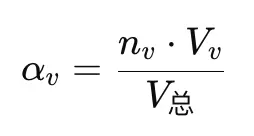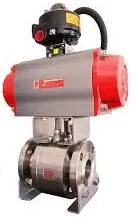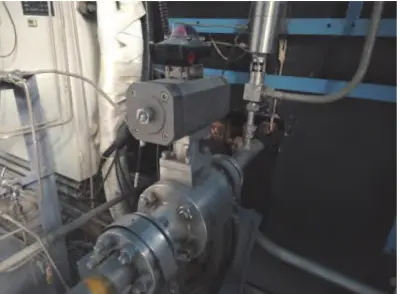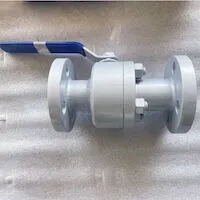Research on Cavitation Suppression in V-Type Control Ball Valves
Feb 12, 2025
The V-type control ball valve is widely used in industries such as petrochemical, metallurgy, and electric power due to its simple structure, excellent sealing performance, and high precision in flow regulation. However, under high-pressure differentials and large flow conditions, cavitation can develop within the valve's internal flow field. This phenomenon leads to erosion and wear on the valve’s internal surfaces, while generating vibration and noise, which compromises the safety and stability of the pipeline system. This study employs multiphase flow numerical simulations to analyze the flow field characteristics and identify the causes of cavitation in V-type control ball valves under varying operational conditions. To mitigate cavitation, a multi-layer pressure-reducing orifice structure is proposed. Simulation results indicate that the multi-layer pressure-reducing orifice significantly reduces cavitation intensity and vibration noise at the valve outlet, lowering the cavitation volume fraction by approximately 50%. This provides a reliable solution for optimizing valve performance in high-pressure differential applications.
Introduction to V-Type Control Ball Valve and Cavitation Challenges
The V-type control ball valve is a compact, high-precision valve renowned for its exceptional flow regulation performance. It is widely used in industrial applications requiring precise flow control, such as pipeline transportation, energy engineering, and fine chemical production. The valve’s V-shaped core ensures accurate flow control across various openings while providing reliable sealing and durability. As a result, the valve is integral to many industrial systems. However, cavitation remains a significant challenge that affects the valve's performance. When liquid flows through the valve core, localized pressure may drop below the saturated vapor pressure due to high-speed jets and steep pressure gradients, leading to cavitation. The formation and collapse of cavitation bubbles can cause surface erosion on both the valve and pipeline, in addition to generating high-frequency vibration and noise. These effects not only reduce the valve's service life but also present serious risks to system safety.
Research Status and Innovations in Cavitation Suppression of V-Type Control Ball Valves
1.1 Research Status: Domestic and International Perspectives
Extensive research has been conducted globally to address valve cavitation, focusing on analyzing flow field characteristics, developing cavitation suppression methods, and optimizing valve designs. For example, Wu et al. used computational fluid dynamics (CFD) to study cavitation in overflow valves, identifying high-speed jets near the valve port as a primary cause. Zhang et al. applied the improved Schnerr-Sauer cavitation model to analyze cavitation evolution in butterfly valves and its impact on valve performance. Domestic researchers, including Wang Weiwei, demonstrated experimentally that reducing the valve opening can lower cavitation intensity, although it limits the flow adjustment range. In V-type control ball valve studies, Mao Wei and colleagues observed severe cavitation near the valve core inlet and outlet when the valve opening was below 20° or above 80°. Sui Fan designed a multi-stage pressure reduction sleeve that achieves graded fluid decompression, reducing cavitation intensity and pressure fluctuations. Meng Xiangrui suggested that optimizing valve core geometry based on pressure distribution analysis could mitigate the effects of high-speed jets, reducing cavitation.
1.2 Research Focus and Innovations of This Paper
Current research on V-type control ball valve cavitation primarily focuses on optimizing valve core structures, with limited exploration of global fluid pressure distribution control. This paper presents a multi-layer pressure reduction orifice design, which incrementally reduces fluid pressure and mitigates the effects of high-speed jets, addressing cavitation at its source. The main innovation of this study is the integration of this multi-layer pressure relief structure with the V-type control ball valve. The paper analyzes its cavitation suppression effects through system simulations, offering both a theoretical foundation and design guidelines for practical engineering applications.
2.1 Numerical Model
CFD software is used for multiphase flow numerical simulation, applying the Reynolds-averaged Navier-Stokes (RANS) equations in combination with the Schnerr-Sauer cavitation model to analyze the flow field. To ensure model accuracy, the following key assumptions are made:
- The fluid is an incompressible, single-phase liquid with constant density and viscosity.
- The generation and collapse of cavitation bubbles follow local thermodynamic equilibrium.
- Viscous resistance from the valve body's inner wall is neglected.
- The Schnerr-Sauer model simulates cavitation by describing the mass transfer between the vapor and liquid phases. The cavitation volume fraction is calculated using the following formula:

where αv represents the cavitation volume fraction, nv is the number of cavitation bubbles per unit volume, Vv is the volume of a single bubble, and Vtotal is the total volume.
2.2 Geometric Modeling and Meshing
A V-type control ball valve model is created using 3D modeling software based on actual industry parameters, with particular attention to the valve core and outlet areas. To assess the function of the pressure reduction orifice, a multi-layer structure is incorporated downstream of the valve core, with optimized orifice plate opening rates and spacing. Unstructured meshing is applied to refine regions with significant fluid flow variations, such as the valve core and orifice plate, ensuring accurate and stable simulation results.
2.3 Boundary Conditions
- Inlet boundary: A constant flow condition is applied, with a flow velocity range of 5–20 m/s.
- Outlet boundary: A fixed pressure condition is applied, based on typical industrial values.
- Wall boundary: A no-slip condition is applied to accurately reflect fluid flow behavior.
3.1 Cavitation Characteristics Without Orifice
Simulation results indicate that without a pressure-reducing orifice, the flow velocity at the valve core outlet increases sharply, causing a rapid drop in local pressure below the saturated vapor pressure, leading to extensive cavitation. Cavitation primarily occurs within a region extending five pipe diameters downstream of the valve core outlet, with the cavitation volume fraction reaching 0.3, accompanied by significant vibration and noise.
3.2 Optimization Effect of Multi-Layer Pressure-Reducing Orifice
The introduction of a multi-layer pressure-reducing orifice gradually reduces fluid pressure, significantly mitigating the pressure gradient and flow velocity fluctuations at the valve core outlet. Simulation data indicate the following:
- The cavitation area is reduced, with the cavitation volume fraction decreasing to 0.15.
- Vibration and noise intensity decrease by approximately 30%.
- Turbulence intensity near the valve core is reduced.
4. Conclusion
This study investigates the cavitation characteristics of V-type regulating ball valves under high-pressure differentials and large-flow conditions using numerical simulations and proposes an optimized design incorporating a multi-layer pressure-reducing orifice. The following conclusions are drawn from the research findings:
Cavitation Phenomenon and Its Impact: Without the pressure-reducing orifice, significant cavitation is observed in the outlet area of the V-type regulating ball valve, characterized by a sharp drop in local pressure and the formation and collapse of bubbles caused by high-speed jets. Cavitation results in erosion of valve and pipeline surfaces, generates high-frequency vibrations and noise, and severely impacts system stability and valve lifespan.
Effectiveness of the Multi-Layer Pressure-Reducing Orifice: The multi-layer pressure-reducing orifice effectively reduces the pressure gradient and flow velocity fluctuations at the valve core outlet by gradually reducing fluid pressure, significantly suppressing the onset and progression of cavitation. Simulation results show a 50% reduction in cavitation volume fraction, a 30% decrease in vibration and noise intensity, and effective control of fluid turbulence. These findings demonstrate that the multi-layer pressure-reducing orifice is an effective solution for suppressing cavitation.
Engineering Application Value: The multi-layer pressure-reducing orifice design proposed in this study provides reliable technical support for valve optimization under high-pressure differential conditions. In industrial applications, this solution significantly enhances the operating reliability and service life of V-type regulating ball valves, while reducing maintenance costs and system safety risks.
In summary, by integrating multiphase flow simulation technology with structural optimization, this study presents a scientific and practical approach to addressing the cavitation problem in V-type regulating ball valves. Future work should focus on optimizing the structural parameters and layout design of the pressure-reducing orifice to accommodate various working conditions, further enhancing the engineering applicability of the optimization scheme through experimental validation.
Previous: Simulation Analysis of Cryogenic Ball Valve Based on Thermo-Solid Coupling
Next: Fault Analysis of Electric Gate Valve Based on Finite Element Analysis


